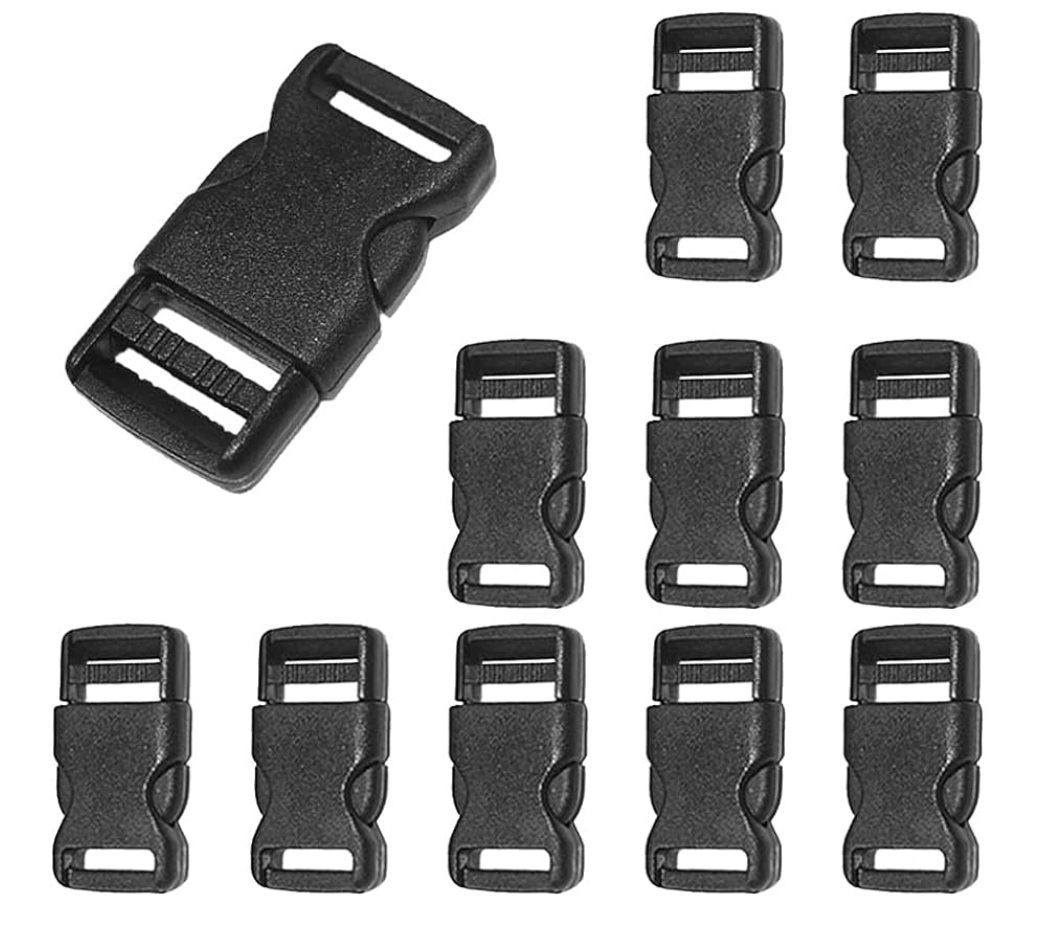Plastic buckles play a vital role in various industries, providing a secure and convenient way to fasten straps. They are versatile, lightweight, and cost-effective, making them a popular choice for applications ranging from outdoor gear to luggage. In this article, we’ll explore the world of plastic buckles, their different types, the materials used, and their durability. If you’re looking for a reliable Webbing and Buckles Manufacturer in USA, you’ll also discover key insights into finding the right supplier for your needs.
What Are Plastic Buckles?
Plastic buckles are mechanical fasteners designed to join two ends of a strap securely. They come in a variety of shapes and sizes, each tailored to specific applications. Some common types of plastic buckles include side-release buckles, cam buckles, ladderlock buckles, and tri-glide buckles.
What Type of Plastic Is Used for Buckles?
Plastic buckles are typically made from various types of plastic materials, each chosen for its specific characteristics and suitability for different applications. Here are some common types of plastics used for making buckles:
1. Acetal (Polyoxymethylene, POM)
Acetal is a popular choice for manufacturing buckles, especially in applications that require high strength and durability. It is known for its excellent mechanical properties, resistance to moisture, and UV stability. These qualities make acetal buckles ideal for outdoor gear like backpacks, camping equipment, and even some automotive components.
2. Nylon
Nylon buckles are another common choice due to their high strength and durability. Nylon is resistant to abrasion and chemicals, making it suitable for various applications, including pet collars, harnesses, and luggage.
3. Polypropylene
Polypropylene is a lightweight and cost-effective plastic material often used in disposable applications, such as packaging. While it may not be as strong as acetal or nylon, polypropylene buckles are suitable for less demanding uses where affordability is a key factor.
4. Polyethylene
Polyethylene buckles are less common but are occasionally used in specific applications. Polyethylene is lightweight and resistant to moisture, but it may not provide the same level of strength as acetal or nylon.
5. ABS (Acrylonitrile Butadiene Styrene)
ABS plastic is known for its impact resistance and strength. It is often used in consumer products, such as child safety seats and some types of belts.
6. Polycarbonate
Polycarbonate is a strong and durable plastic with high impact resistance. It is occasionally used in applications where the buckle may be subject to heavy loads or impacts.
The choice of plastic material for a buckle depends on the intended use, considering factors like strength, durability, resistance to environmental conditions, and cost-effectiveness. Different types of plastic offer varying degrees of these characteristics, allowing manufacturers to select the most suitable material for their specific applications.
What Is the Best Material for a Buckle?
The choice of the best material for Military Belt Buckles largely depends on the specific requirements and intended use of the buckle. Different plastic materials offer unique characteristics, and the “best” material varies from one application to another. Here’s a breakdown of the considerations for choosing the best material for military belt buckles:
1. Strength
For applications that require high strength, such as outdoor gear or safety equipment, materials like acetal, nylon, or polycarbonate are often preferred.
2. Durability
If the buckle will be exposed to harsh environmental conditions, including moisture and UV radiation, acetal and nylon are excellent choices due to their durability.
3. Cost
For budget-conscious projects or disposable applications, polypropylene may be the best option due to its affordability.
4. Weight
Lightweight applications may benefit from materials like polypropylene or ABS.
5. Chemical Resistance
Consider the presence of chemicals or substances the buckle may come into contact with and choose a material that is resistant to these factors.
Ultimately, the best material for a buckle is the one that aligns with the specific demands of your project or product. Careful consideration of the material’s properties and the intended use will help you make an informed decision.
Are Plastic Buckles Durable?
Yes, high-quality plastic buckles are indeed durable. They are designed and manufactured to withstand a variety of environmental conditions and everyday wear and tear. The durability of plastic buckles is one of the key reasons for their widespread use in various applications.
Here are some factors that contribute to the durability of plastic buckles:
1. Resistance to Moisture
Many plastic materials used for buckles, such as acetal (POM) and nylon, are resistant to moisture. This means they won’t degrade or weaken when exposed to water or humidity. This quality makes plastic buckles suitable for outdoor gear, marine applications, and other situations where exposure to moisture is common.
2. UV Stability
High-quality plastic buckles are often UV-stabilized. This means they can endure exposure to sunlight without degrading or becoming brittle over time. This feature is particularly important for outdoor gear like backpacks, tents, and camping equipment.
3. Temperature Resistance
Plastic buckles can withstand a wide range of temperatures. While extreme heat can affect some plastics, high-quality buckles are designed to maintain their integrity in various weather conditions.
4. Chemical Resistance
Depending on the plastic material used, buckles can be resistant to a variety of chemicals. This property is crucial in applications where exposure to chemicals or solvents is a concern.
5. Abrasion Resistance
Plastic buckles made from durable materials like nylon are resistant to abrasion, which means they can endure friction and rubbing without significant wear and tear.
6. Load-Bearing Capacity
High-quality plastic buckles are engineered to provide the necessary load-bearing capacity for their intended applications. They can handle the stress and strain associated with securing straps, even in heavy-duty uses.
It’s important to note that the durability of plastic buckles can vary depending on the quality of the material and the manufacturing process. Choosing reputable manufacturers and suppliers is essential to ensure that you get durable plastic buckles that meet your specific needs.
How Do You Attach a Strap to a Plastic Buckle?
Attaching a strap to a plastic buckle is a straightforward process. Different types of buckles may have variations in how they are connected, but the basic principle remains the same.
1. Side-Release Buckles
To attach a strap to a side-release buckle, insert one end of the strap through the female part of the buckle and then slide it through the male part. Push down on the male part until it clicks into place, securing the strap.
2. Cam Buckles
For cam buckles, thread the strap through the bottom slot and then back over the top of the cam. Pull the strap to tighten it, and the cam will grip the strap securely.
3. Ladderlock Buckles
Ladderlock buckles are commonly used for adjusting strap length. Thread the strap through the bottom and up through the top slot of the buckle. To tighten or loosen the strap, simply move it through the ladder slots as needed.
4. Tri-Glide Buckles
Tri-glide buckles are used for securing straps without any permanent attachment. Thread the strap through the three slots, and adjust the length as required.
Conclusion
Plastic buckles are indispensable components in many products we use daily, offering secure and convenient fastening solutions. When choosing plastic buckles for your application, consider the type of plastic material that best suits your needs. High-quality materials like acetal (POM), nylon, and polypropylene provide durability and longevity, ensuring that your straps stay securely fastened. With their versatility and reliability, plastic buckles continue to play a crucial role in numerous industries.
FAQ’s
Are plastic buckles strong enough for heavy-duty applications?
Yes, some plastic buckles, such as those made from acetal (POM) or nylon, are suitable for heavy-duty applications, providing strength and durability.
Can plastic buckles withstand exposure to the elements?
Yes, high-quality plastic buckles are designed to resist moisture, UV radiation, and extreme temperatures, making them ideal for outdoor use.
How do I clean plastic buckles?
To clean plastic buckles, use a mild soap and water solution. Avoid using harsh chemicals or abrasive materials that could damage the plastic.
Are there any eco-friendly plastic buckle options?
Some manufacturers offer eco-friendly plastic buckles made from recycled materials. These options contribute to sustainability efforts and reduce environmental impact.





























